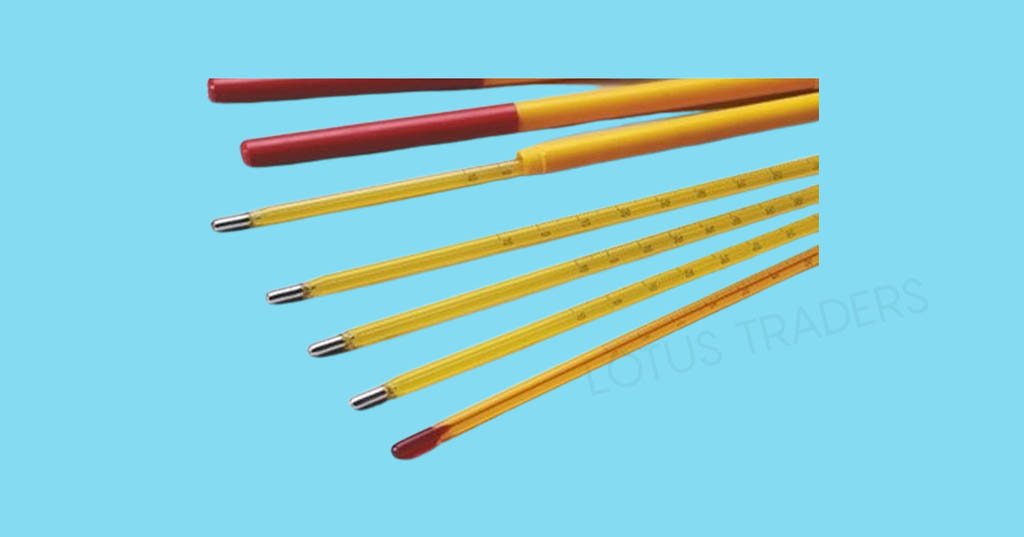Features |
Specifications |
|---|---|
|
Laboratory Thermometer Range |
-100 degree C to + 600 degree C
|
|
Minimum Order Quantity
|
1 Piece
|
Product Description - Laboratory Thermometers
A laboratory thermometer measures temperature other than human body temperature. It varies from -10˚C to 110˚C. Laboratory thermometers are designed for laboratory purposes, for example to check the boiling point, freezing point or temperature of other substances. You can use a laboratory thermometer to check the temperature of a solvent, but not a clinical thermometer.
Chemical Laboratory Thermometers are manufactured using high quality glass capillaries with prominent mercury or alcohol column as needed for accurate results in research laboratories, institutes, schools, universities and general private sector laboratories.
The available temperature range is between -100°C and +600°C. Consumers must provide the specified range, smallest number and accuracy class. We can also supply according to customers’ drawings and samples.
Laboratory thermometers are used to measure temperature or temperature changes with great accuracy. They are made of metal or glass and are hardened by hot quenching or annealing.
How a laboratory thermometer works depends on its type. These are typically liquid glass devices, bimetallic strips, electronic thermistor thermometers, or infrared (IR) devices.
How to read / measure with a Thermometer?
Firstly, the thermometer is washed with normal temperature water.
Then give some jerks. We have found that jerks lowers the mercury level. We guarantee it will drop below the 37⁰C or 98⁰F mark, the normal human body temperature.
The thermometer is then held under the tongue or under the arms to obtain the thermometer reading.
The thermometer is then held close to the eye to see the correct reading.
The temperature difference displayed between the two largest marks is noted. Also, the number of divisions which is indicated by smaller marks in between these marks is noted. For example- The largest mark is 10 and the number of divisions is 5, so each division reads the value that is equal to 10/5 = 20
We recorded the highest brand value that crossed the mercury thread. Then the division number of the crossed mercury thread is recorded. Now this value is multiplied by the value of one division. Therefore, the temperature reading is 98 + (3×2) = 98.6.
Laboratory Thermometer diagram with label

Laboratory Thermometer Uses
Where laboratory thermometer is used?
Laboratory thermometers are commonly used in scientific and research applications such as controlling experiments, maintaining a non-contaminated work environment, calibrating other laboratory instruments and testing materials.
A laboratory thermometer can be used for many scientific applications and can be found in almost any laboratory, particularly in pharmaceutical, environmental, food and petroleum testing. Although a laboratory thermometer can measure the heat or coldness of a sample or environment, the measurement range can vary greatly between models.
How does laboratory thermometer work?
Structure:
As the thermometer is relatively small, it is therefore portable and inexpensive.
The liquid is in a thin-walled glass flask. The piston is relatively larger than its diameter to accommodate more fluid and improve sensitivity.
The narrow orifice of the capillary tube is even. The round glass shaft around the capillary tube is thick. It looks like a magnifying glass.
Sensitivity:
A small expansion of the liquid in the liquid sphere causes a large change in the length of the liquid strand in the capillary tube as it narrows. The narrower the hole, the greater the sensitivity.
Region:
The range is often limited by the freezing and boiling points of the liquid.
For mercury thermometers it is -39 to 357°C
For alcohol glass thermometers it is -115 to 78°C
Most of the liquid-in-glass thermometers used in cold countries use alcohol instead of mercury.
The range can be increased by lengthening the hole.
Range is the opposite of sensitivity, that is, the larger the field, the lower its sensitivity. Factors that increase capacity would simultaneously decrease its sensitivity.
Linearity:
Mercury expands fairly uniformly over a wide range of temperature.
Alcohol expands non-linearly over a different temperature range.
Difference between laboratory thermometer and clinical thermometer
A clinical thermometer is used to measure human body temperature while a laboratory thermometer is used to measure above average human body temperature. The article helps students understand the functioning and construction of thermometers.


